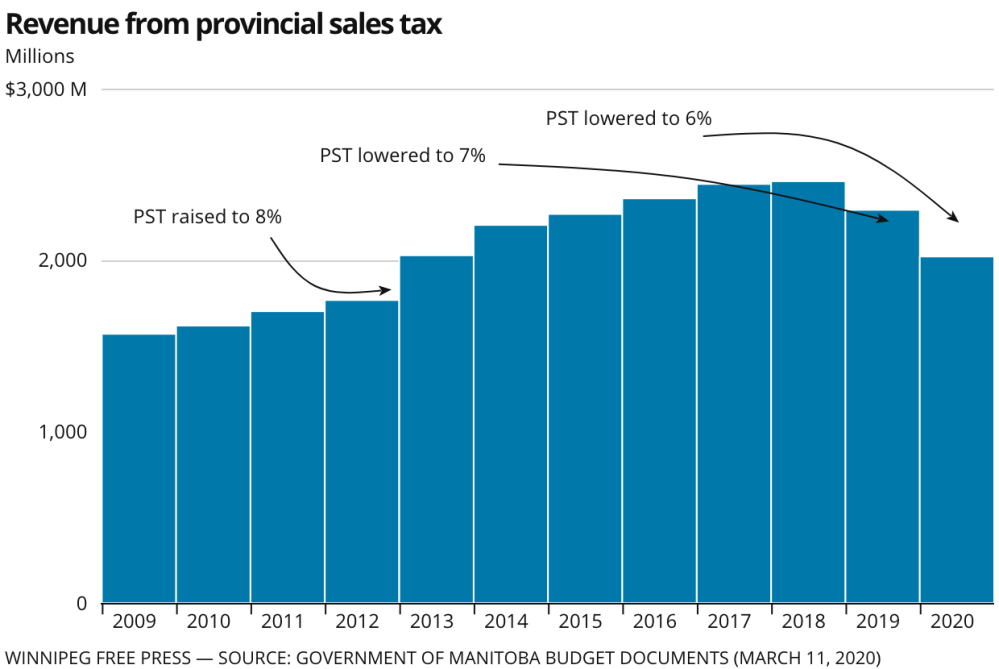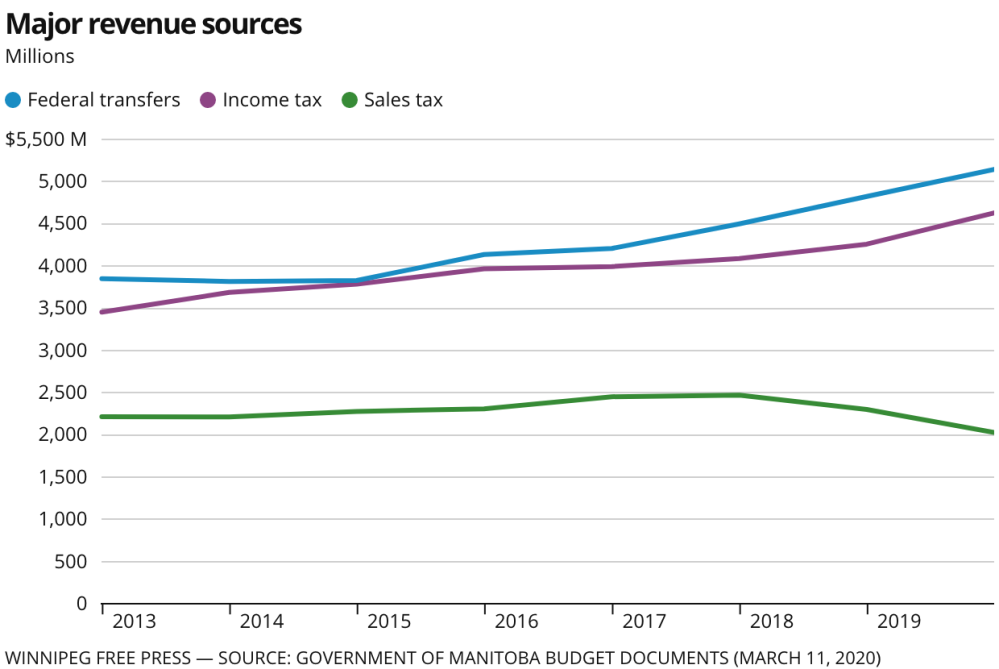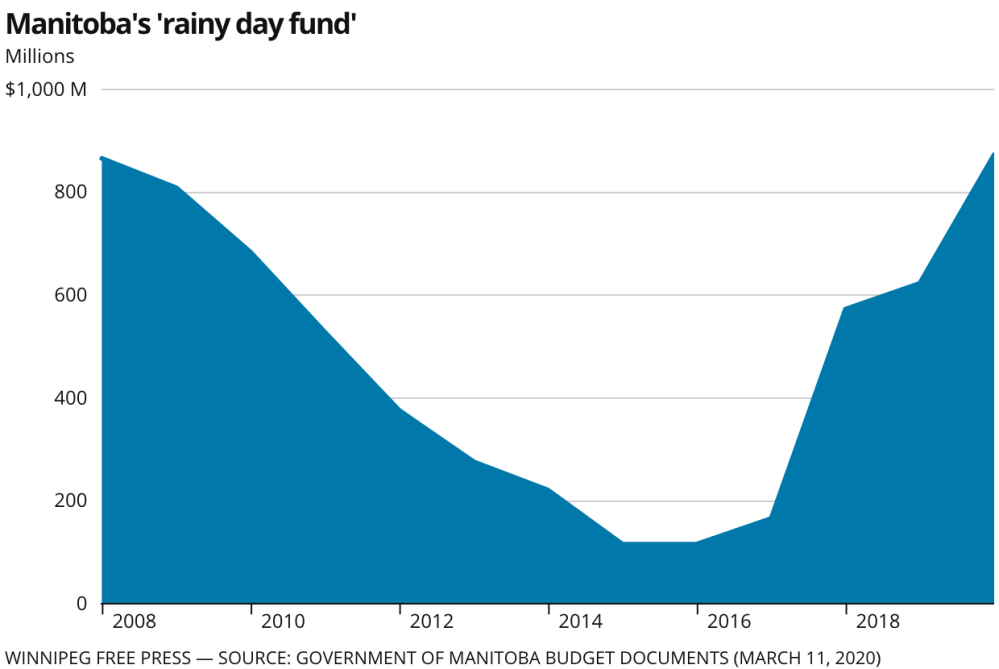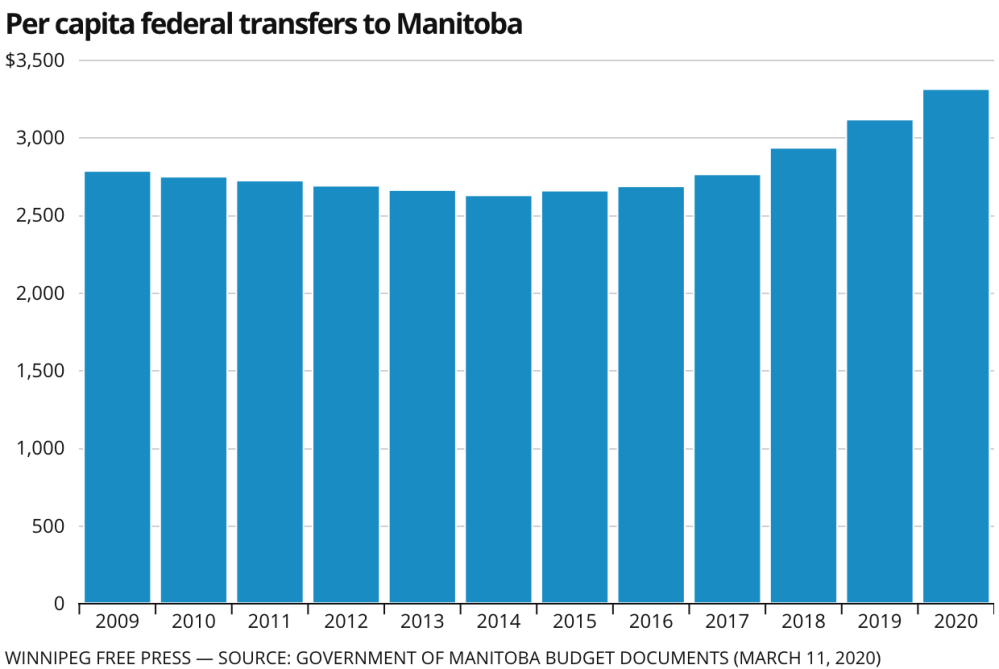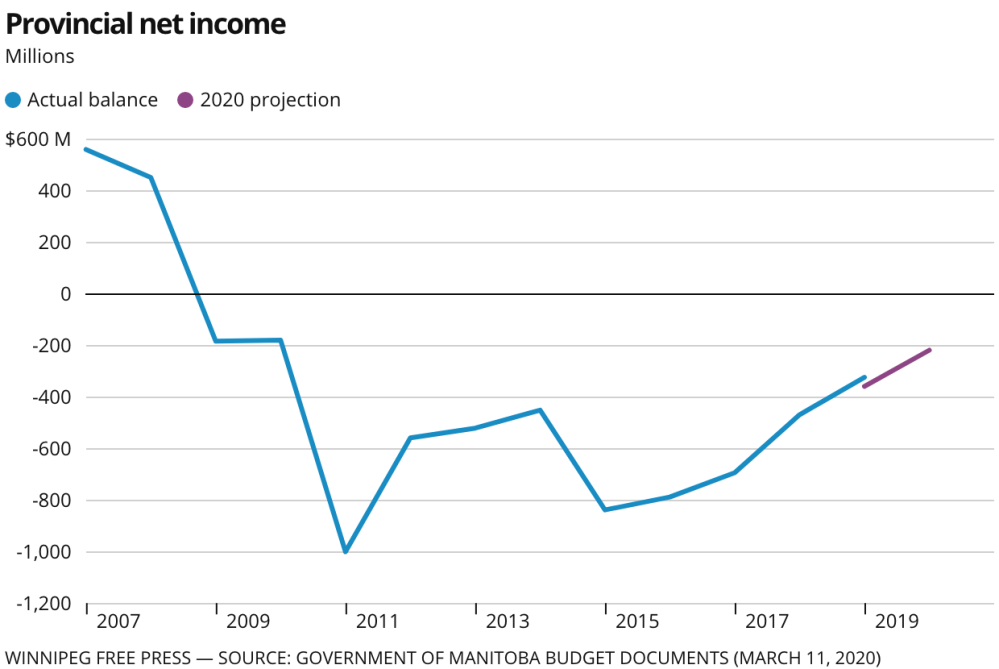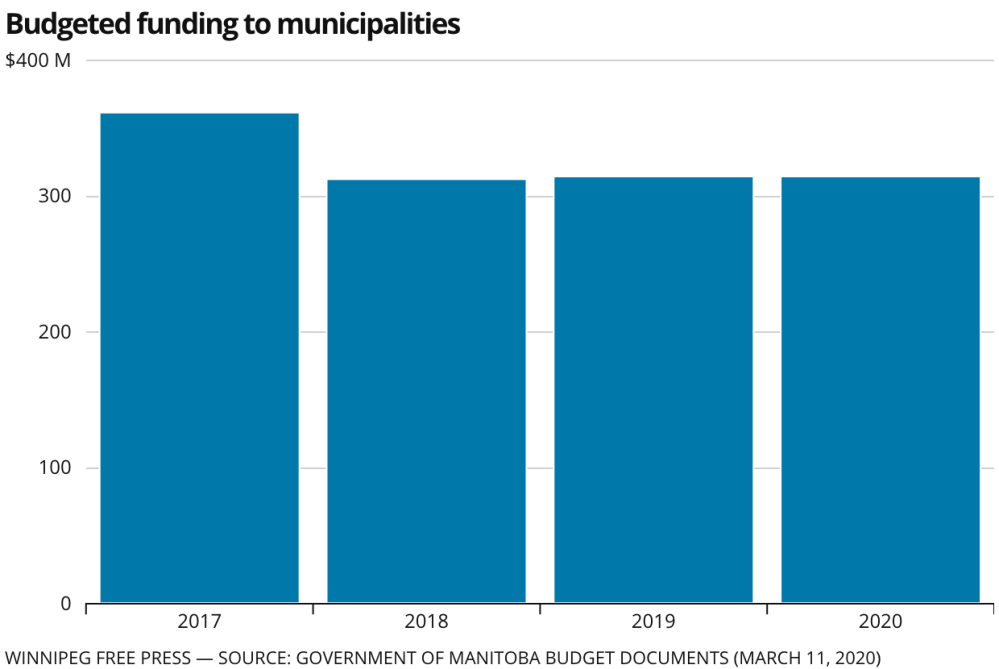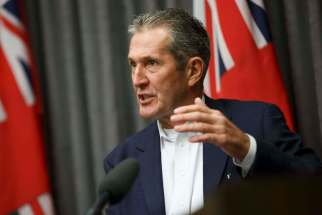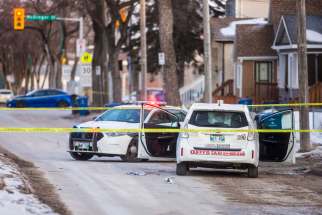A budget with bits for everyone, and COVID-19, too Deficit, PST down, while spending on infrastructure, education, health rises
Read this article for free:
or
Already have an account? Log in here »
To continue reading, please subscribe:
Monthly Digital Subscription
$0 for the first 4 weeks*
- Enjoy unlimited reading on winnipegfreepress.com
- Read the E-Edition, our digital replica newspaper
- Access News Break, our award-winning app
- Play interactive puzzles
*No charge for 4 weeks then price increases to the regular rate of $19.00 plus GST every four weeks. Offer available to new and qualified returning subscribers only. Cancel any time.
Monthly Digital Subscription
$4.75/week*
- Enjoy unlimited reading on winnipegfreepress.com
- Read the E-Edition, our digital replica newspaper
- Access News Break, our award-winning app
- Play interactive puzzles
*Billed as $19 plus GST every four weeks. Cancel any time.
To continue reading, please subscribe:
Add Free Press access to your Brandon Sun subscription for only an additional
$1 for the first 4 weeks*
*Your next subscription payment will increase by $1.00 and you will be charged $16.99 plus GST for four weeks. After four weeks, your payment will increase to $23.99 plus GST every four weeks.
Read unlimited articles for free today:
or
Already have an account? Log in here »
Hey there, time traveller!
This article was published 19/03/2020 (2095 days ago), so information in it may no longer be current.
The Pallister government is hailing its 2020 budget as the most emergency-ready financial plan in Manitoba’s history, as it prepares for global economic uncertainty, a pandemic, and local emergencies such as spring flooding.
At the same time, Finance Minister Scott Fielding said the document aims to make life more affordable for Manitobans so they can better ride out a financial storm with a provincial sales tax decrease. The one-point deduction was unveiled March 5; one of several budget highlights the government had already announced.
Deficit reduction
Before the latest COVID-19-related budget update, Fielding was projecting to reduce the provincial budget deficit to $220 million in the fiscal year, beginning April 1. The latest deficit estimate for the current fiscal year is $325 million.
PST cut
The PST reduction to six per cent from seven per cent takes effect July 1, and is expected to save an average of $345 per household. Smokers will not get a break, as the government is offsetting it with a tobacco tax hike to ensure the retail price remains the same. A proposal announced earlier to eliminate the PST on salon services and home insurance will be in next year’s budget.
Emergencies and disasters
The province will replenish its rainy day fund and contribute an additional $300 million by the end of 2020-21. It expects it will result in a balance of $872 million — and be fully funded. The original budget document published before COVID-19 was declared a pandemic said the novel coronavirus could “materially impact” GDP growth in 2020, which is expected to slow to 5.8 per cent.
An additional $188,000 in funding is allocated to the Cadham Provincial Laboratory to “respond to population-wide outbreaks.” There’s $5.7 million in funding for the Department of Infrastructure to react to “smaller-scale floods or other emergency events.”
The emergency expenditures contingency for “forest fires, flooding and other natural resources” is increased to $100 million, up 126 per cent from $44 million last year. It includes provisions for environmental emergency responses and funding for losses and expenses incurred by various Crown corporations, agencies, boards and commissions.
Health spending
The Pallister government said in its original budget document — before COVID-19 was declared a pandemic — that it is making a record $6.82-billion investment in health care, an increase of 1.6 per cent over last year.
It includes several capital projects such as the $593-million Health Sciences Centre master campus plan and $88.5 million for St. Boniface Hospital redevelopment. The government is spending $250 million on rural and northern health care, including digital supports and infrastructure. Funding for mental health and addictions will increase by $2 million, to $22 million, under the federal-provincial funding plan.
On March 10, an emergency funding bill for $35.2 million was passed in the house and given royal assent. Thursday’s budget supplement said COVID-19 will impact Manitoba’s total summary expenditures “significantly.”
The government in recent days has set aside $2.7 million for the purchase of up to 43 ventilator machines, $410,000 for 13 continuous dialysis renal replacement machines for intensive care unit dialysis, and $80,000 for a nucleic acid extractor to to enhance local capacity for rapid COVID-19 testing.
Education spending
There are $1.3 billion in operating grants to school divisions, with a $160-million investment in capital projects in the kindergarten to Grade 12 education system. The investment includes 4,425 new classroom spaces open or under construction by the end of the 2020-21 fiscal year, with seven new schools, additions and renovation projects.
University funding
The province has designated $41 million for interest-free student loans, an increase of $5 million, and is increasing the bursaries and scholarships program by $4.8 million. It has directed colleges and universities to cap any tuition increases at 3.75 per cent.
Water problems
The province is providing an additional $21.8 million to be held in reserve for the North End Water Pollution Control Centre overhaul in Winnipeg, bringing the total provincial contribution to more than $56 million. Manitoba said it will continue to work with the city and the federal government “to ensure funding is in place for this important project,” but did not reveal future funding for the multibillion-dollar project.
It has allocated $101 million for the Lake Manitoba and Lake St. Martin channels project — an “exponential increase” over last year, said Fielding.
Climate change
The budget has been touted by Tory Premier Brian Pallister as the greenest in Manitoba’s history, but there are no specific projects to reduce greenhouse gases. Its $25 per tonne carbon tax proposed for July 1, “could potentially have an impact on behaviour,” Fielding said. The government had previously announced several environmental measures, such as funding for lead-contaminated soil remediation. There is also a one-time capital investment of $45 million for unspecified “climate resiliency projects.”
Daycare
The province is spending $2.7 million in its 2020 budget for the addition of 1,087 licensed early learning and child-care spaces, with 50 new home-based spaces, but no additional operating funding for licensed daycares.
Highways and housing
Funding for Manitoba Infrastructure increases by 7.2 per cent, to $494 million. Capital funding for highways rises slightly by $12.5 million, to $362.5 million.
Funding for Manitoba Housing and Renewal Corp. increases by $10 million, and the budget allocates $12.7 million towards a plan to “dissolve” the Manitoba Housing Development Renewal Fund and reinvest the money to address the deficit in housing stock. The role of the Crown corporation will shift from housing provider to funder and regulator, the budget speech says. Expenses have decreased year-over-year, as some of its housing transitioned to the not-for-profit sector.
Policing
“While others choose to treat thugs and thieves as victims, our concern is for the real victims of crime,” Fielding said in his budget speech, announcing $561,000 for grants to support community projects that support victims of crime. It is an increase of $29,000.
The government is allocating $6 million for provincial police service agreements, which will include funding for 27 additional officers. An additional $3.6 million has been earmarked to address crime and gang activity, and $2.3 million for the policing and public safety strategy, “so Manitobans feel safe in their homes,” Fielding said.
carol.sanders@freepress.mb.ca

Our newsroom depends on a growing audience of readers to power our journalism. If you are not a paid reader, please consider becoming a subscriber.
Our newsroom depends on its audience of readers to power our journalism. Thank you for your support.
History
Updated on Thursday, March 19, 2020 4:53 PM CDT: Updates deficit scenario chart
Updated on Thursday, March 19, 2020 5:41 PM CDT: Fixes typo.
Updated on Thursday, March 19, 2020 5:51 PM CDT: Removes information on total education department funding increase.
Updated on Thursday, March 19, 2020 7:11 PM CDT: Updates final story


